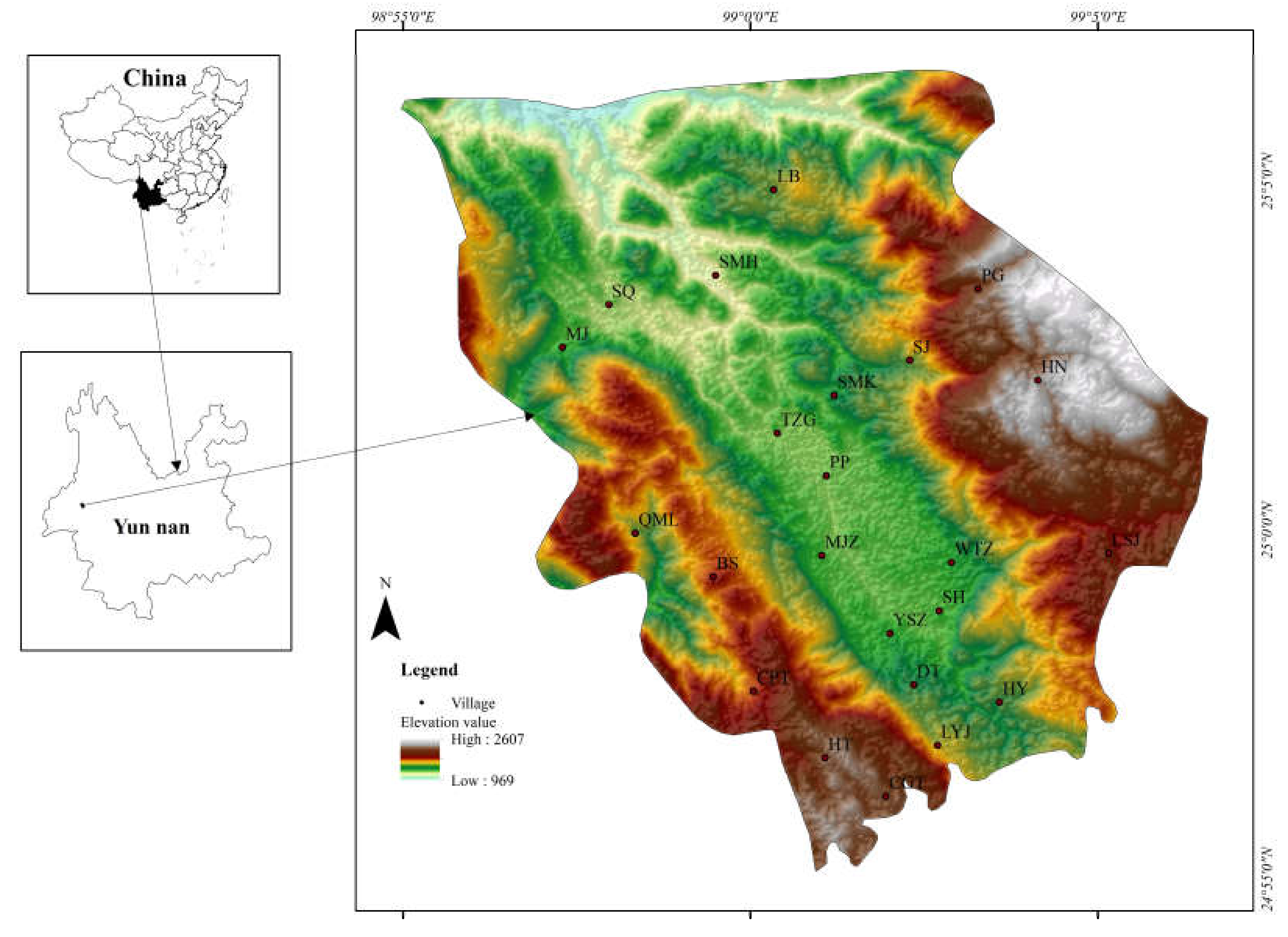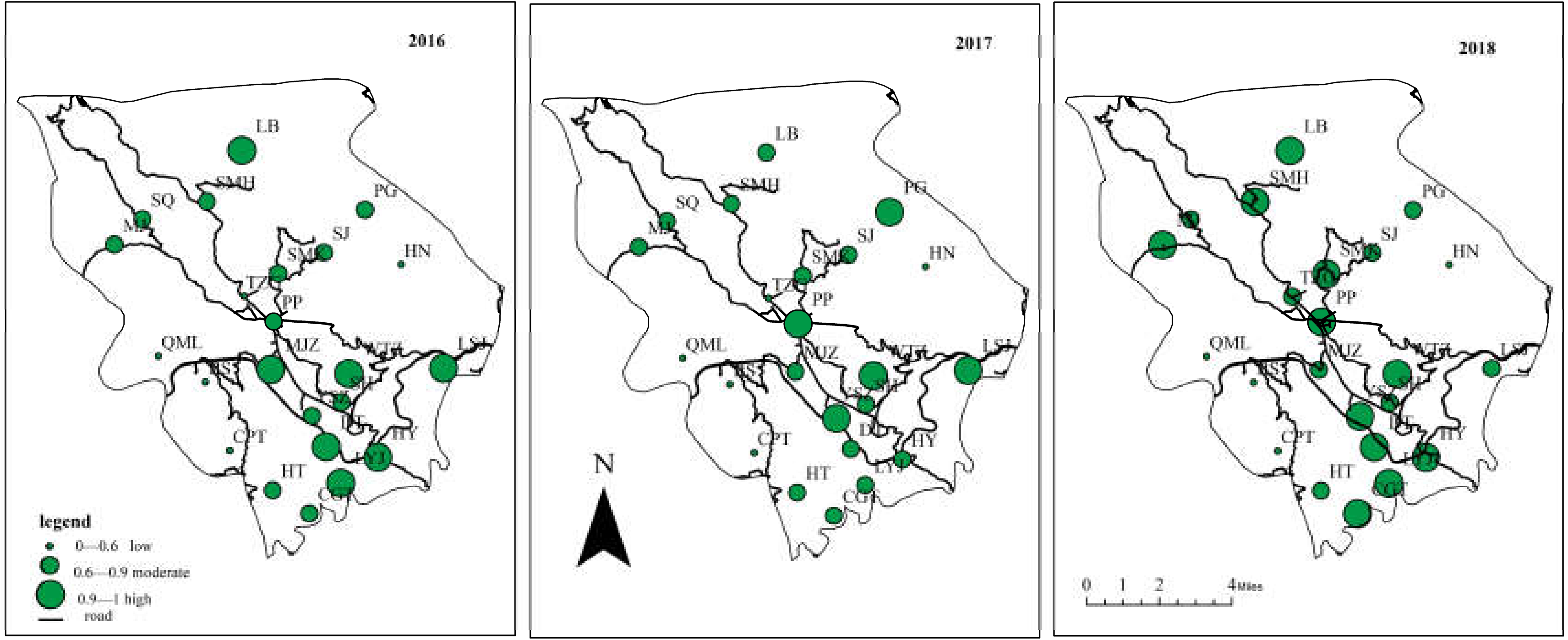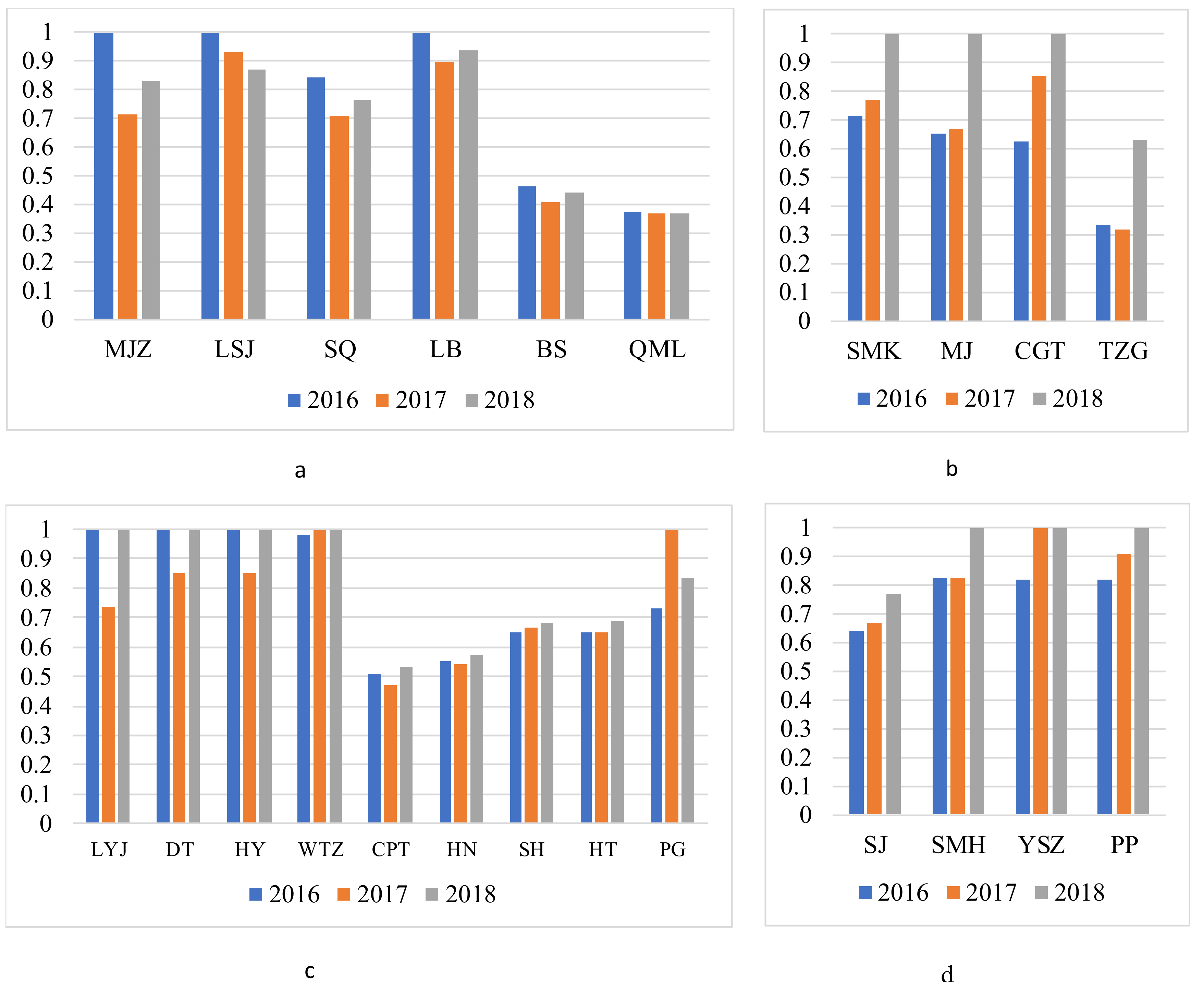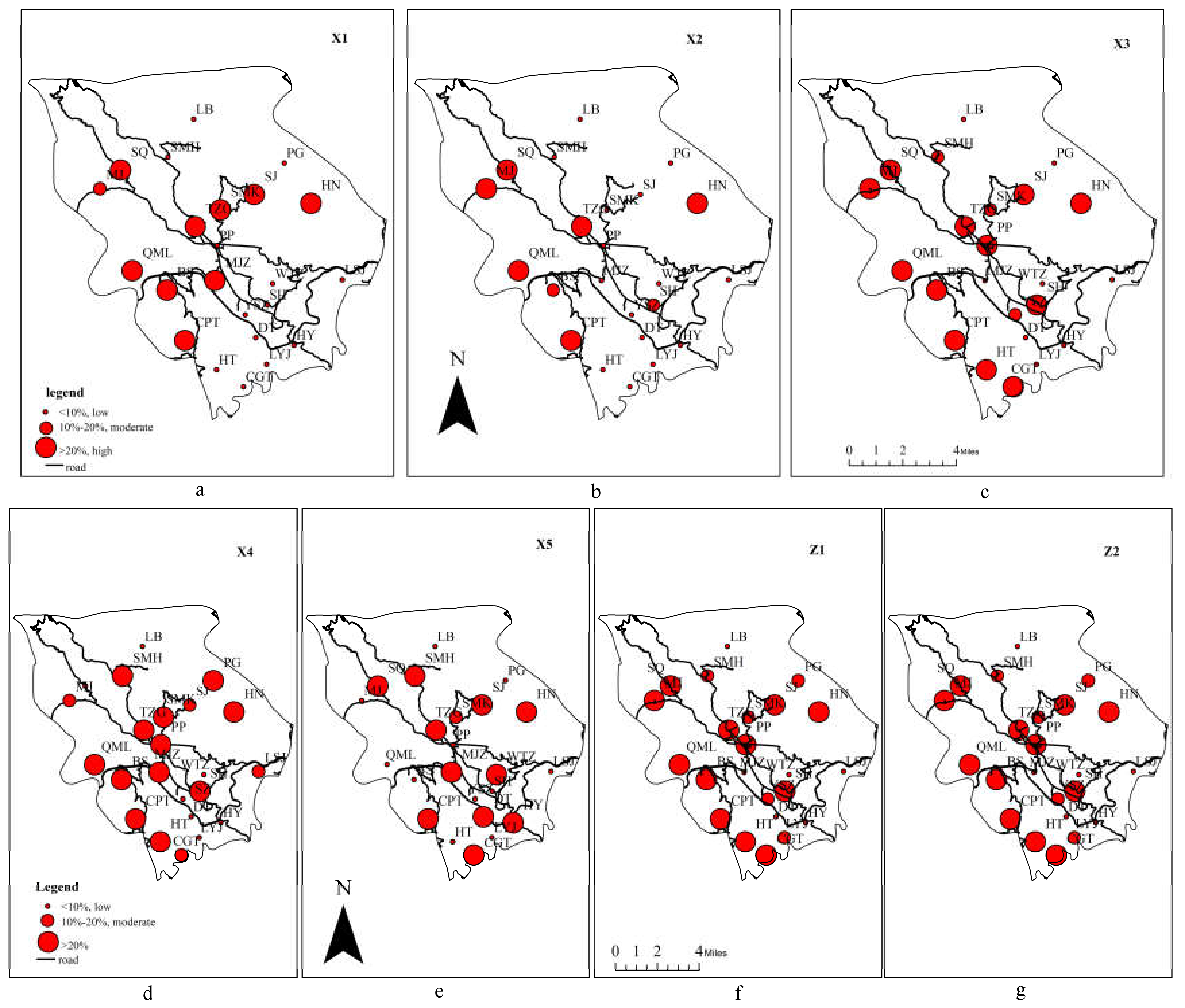How Much Is the Eco-Efficiency of Agricultural Production in West China? Evidence from the Village Level Data
Abstract
1. Introduction
2. Materials and Methods
2.1. Study Areas
2.2. Data
2.3. Research Methods
2.3.1. Evaluation Index System
2.3.2. Eco-Efficiency of Agriculture
3. Results
3.1. Spatial-Temporal Pattern of the Agricultural Eco-Efficiency in Pupiao Town
3.1.1. Spatial Pattern of the Agricultural Eco-Efficiency
3.1.2. Temporal Pattern of the Agricultural Eco-Efficiency
3.2. Reasons for Agricultural Eco-Efficiency Loss in Pupiao Town
4. Discussion
5. Conclusions
Author Contributions
Funding
Acknowledgments
Conflicts of Interest
References
- Pavithra, S.; Vatta, K. Role of Non-Farm Sector in Sustaining Rural Livelihoods in Punjab. Agric. Econ. Res. Rev. 2013, 26, 257–265. [Google Scholar]
- Elahi, E.; Abid, M.; Zhang, L.; Haq, S.U.; Sahito, J. Agricultural advisory and financial services; farm level access, outreach and impact in a mixed cropping district of Punjab, Pakistan. Land Use Policy 2018, 71, 249–260. [Google Scholar] [CrossRef]
- Elahi, E.; Weijun, C.; Zhang, H.; Abid, M. Use of artificial neural networks to rescue agrochemical-based health hazards: A resource optimisation method for cleaner crop production. J. Clean. Prod. 2019, 238, 117900. [Google Scholar] [CrossRef]
- Carlos, R.P.; Marques, S.A.L.; Pettenuzzo, D.B.P.A.; Rosa, F.V.; Patrícia, G.; Marini, T.K. Environmental preservation costs and eco-efficiency in Amazonian agriculture: Application of hyperbolic distance functions. J. Cleaner Prod. 2018, 197, 699–707. [Google Scholar]
- Ahirwar, N.K.; Singh, R.; Chaurasia, S.; Chandra, R.; Ramana, S. Effective Role of Beneficial Microbes in Achieving the Sustainable Agriculture and Eco-Friendly Environment Development Goals: A Review. Front. Microbiol. 2020, 5, 111–123. [Google Scholar]
- Ouyang, W.; Wu, Y.; Hao, Z.; Zhang, Q.; Bu, Q.; Gao, X. Combined impacts of land use and soil property changes on soil erosion in a mollisol area under long-term agricultural development. Sci. Total. Environ. 2018, 613, 798–809. [Google Scholar] [CrossRef]
- Borrelli, P.; Meusburger, K.; Ballabio, C.; Panagos, P.; Alewell, C. Object-oriented soil erosion modelling: A possible paradigm shift from potential to actual risk assessments in agricultural environments. Land Degrad. Dev. 2018, 29, 1270–1281. [Google Scholar] [CrossRef]
- Melo, W.; Delarica, D.; Guedes, A.; Lavezzo, L.F.; Donha, R.; Araujo, A.S.F.; De Melo, G.M.P.; Macedo, F. Ten years of application of sewage sludge on tropical soil. A balance sheet on agricultural crops and environmental quality. Sci. Total. Environ. 2018, 643, 1493–1501. [Google Scholar] [CrossRef]
- Halstead, N.; Hoover, C.M.; Arakala, A.; Civitello, D.J.; De Leo, G.A.; Gambhir, M.; Johnson, S.A.; Jouanard, N.; Loerns, K.A.; McMahon, T.A.; et al. Agrochemicals increase risk of human schistosomiasis by supporting higher densities of intermediate hosts. Nat. Commun. 2018, 9, 837. [Google Scholar] [CrossRef]
- Cederberg, C.; Persson, U.M.; Schmidt, S.; Hedenus, F.; Wood, R.; Persson, M. Beyond the borders—Burdens of Swedish food consumption due to agrochemicals, greenhouse gases and land-use change. J. Clean. Prod. 2019, 214, 644–652. [Google Scholar] [CrossRef]
- Figueiredo, P.N. New challenges for public research organisations in agricultural innovation in developing economies: Evidence from Embrapa in Brazil’s soybean industry. Q. Rev. Econ. Finance 2016, 62, 21–32. [Google Scholar] [CrossRef][Green Version]
- Zhao, J.; Tang, J. Understanding agricultural growth in China: An international perspective. Struct. Chang. Econ. Dyn. 2018, 46, 43–51. [Google Scholar] [CrossRef]
- Xu, X.; Huang, X.; Huang, J.; Gao, X.; Chen, L. Spatial-Temporal Characteristics of Agriculture Green Total Factor Productivity in China, 1998-2016: Based on More Sophisticated Calculations of Carbon Emissions. Int. J. Environ. Res. Public Heal. 2019, 16, 3932. [Google Scholar] [CrossRef]
- Faggion, F.; Oliveira, C.A.S.; Christofidis, D. Water use efficiency: A contribution to sustainable development of agriculture. Pesqui. Apl. Agrotecnol. 2009, 2, 23–45. [Google Scholar]
- Riveraferre, M.G. The future of agriculture. Agricultural knowledge for economically, socially and environmentally sustainable development. EMBO Rep. 2008, 9, 1061. [Google Scholar]
- Todorović, M.; Mehmeti, A.; Scardigno, A. Eco-efficiency of agricultural water systems: Methodological approach and assessment at meso-level scale. J. Environ. Manag. 2016, 165, 62–71. [Google Scholar] [CrossRef]
- Bonfiglio, A.; Arzeni, A.; Bodini, A. Assessing eco-efficiency of arable farms in rural areas. Agric. Syst. 2017, 151, 114–125. [Google Scholar] [CrossRef]
- Orea, L.; Wall, A. A Parametric Approach to Estimating Eco-Efficiency. J. Agric. Econ. 2017, 68, 901–907. [Google Scholar] [CrossRef]
- Grzelak, A.; Guth, M.; Matuszczak, A.; Czyżewski, B.; Brelik, A. Approaching the environmental sustainable value in agriculture: How factor endowments foster the eco-efficiency. J. Clean. Prod. 2019, 241, 118304. [Google Scholar] [CrossRef]
- Camarero, M.; Castillo, J.; Picazo-Tadeo, A.J.; Tamarit, C.; Giménez, J.C. Eco-Efficiency and Convergence in OECD Countries. Environ. Resour. Econ. 2012, 55, 87–106. [Google Scholar] [CrossRef]
- Faleye, T. Determination of energy consumption in lowland rice production in Nigeria. J. Occup. Med. Off. Publ. Ind. Med. Assoc. 2013, 15, 712–726. [Google Scholar]
- Zhang, N.; Sun, J. Application of the Ratio of Input to Output Method to Performance Assessment of Higher Education Institutions. Higher Educ. Dev. Eval. 2012, 24, 1–32. [Google Scholar]
- Xu, X.; Zhang, L.; Chen, L.; Liu, C. The Role of Soil N2O Emissions in Agricultural Green Total Factor Productivity: An Empirical Study from China around 2006 when Agricultural Tax Was Abolished. Agriculture 2020, 10, 150. [Google Scholar] [CrossRef]
- Bartelmus, P. Dematerialization and capital maintenance: Two sides of the sustainability coin. Ecol. Econ. 2003, 46, 61–81. [Google Scholar] [CrossRef]
- Yanshu, H.; Xiaoli, W.; Ying, X.; Lishu, W.; Cuncang, J. Assessment of economic and environmental impacts of two typical cotton genotypes with contrasting potassium efficiency. J. Plant Nutr. Soil Sci. 2013, 176, 460–465. [Google Scholar] [CrossRef]
- Bina, O.; Jing, W.; Brown, L.; Partidario, M.R. An inquiry into the concept of SEA effectiveness: Towards criteria for Chinese practice. Environ. Impact Assess. Rev. 2011, 31, 572–581. [Google Scholar] [CrossRef]
- Chaudron, C.; Faucher, M.; Bazinet, L.; Margni, M. The cost is not enough—An alternative eco-efficiency approach applied to cranberry de-acidification. J. Clean. Prod. 2019, 232, 391–399. [Google Scholar] [CrossRef]
- Robertson, G.P.; Swinton, S.M. Reconciling agricultural productivity and environmental integrity: A grand challenge for agriculture. Front. Ecol. Environ. 2005, 3, 38–46. [Google Scholar]
- Fan, L.; Niu, H.; Yang, X.; Qin, W.; Bento, C.P.; Ritsema, C.J.; Geissen, V. Factors affecting farmers’ behaviour in pesticide use: Insights from a field study in northern China. Sci. Total. Environ. 2015, 537, 360–368. [Google Scholar] [CrossRef]
- Kim, S.; Dale, B. Global potential bioethanol production from wasted crops and crop residues. Biomass Bioenergy 2004, 26, 361–375. [Google Scholar] [CrossRef]
- Clark, M.; Tilman, D. Comparative analysis of environmental impacts of agricultural production systems, agricultural input efficiency, and food choice. Environ. Res. Lett. 2017, 12, 064016. [Google Scholar] [CrossRef]
- Khan, M.; Damalas, C.A. Farmers’ willingness to pay for less health risks by pesticide use: A case study from the cotton belt of Punjab, Pakistan. Sci. Total. Environ. 2015, 530, 297–303. [Google Scholar] [CrossRef]
- Liu, E.M.; Huang, J. Risk preferences and pesticide use by cotton farmers in China. J. Dev. Econ. 2013, 103, 202–215. [Google Scholar] [CrossRef]
- Huang, X.; Xu, X.; Wang, Q.; Zhang, L.; Gao, X.; Chen, L. Assessment of Agricultural Carbon Emissions and Their Spatiotemporal Changes in China, 1997–2016. Int. J. Environ. Res. Public Health 2019, 16, 3105. [Google Scholar] [CrossRef]
- Murad, W.; Molla, R.I.; Bin Mokhtar, M.; Raquib, A. Climate change and agricultural growth: An examination of the link in Malaysia. Int. J. Clim. Chang. Strat. Manag. 2010, 2, 403–417. [Google Scholar] [CrossRef]
- Akhmat, G.; Zaman, K.; Shukui, T.; Sajjad, F.; Khan, M.A.; Khan, M.Z. The challenges of reducing greenhouse gas emissions and air pollution through energy sources: Evidence from a panel of developed countries. Environ. Sci. Pollut. Res. 2014, 21, 7425–7435. [Google Scholar] [CrossRef]
- Baltas, H.; Sirin, M.; Gökbayrak, E.; Ozcelik, A.E. A case study on pollution and a human health risk assessment of heavy metals in agricultural soils around Sinop province, Turkey. Chemosphere 2019, 241, 125015. [Google Scholar] [CrossRef]
- Zou, L.; Liu, Y.; Wang, Y.; Hu, X. Assessment and analysis of agricultural non-point source pollution loads in China: 1978–2017. J. Environ. Manag. 2020, 263, 110400. [Google Scholar] [CrossRef]
- Adegbeye, M.; Reddy, P.R.K.; Obaisi, A.; Elghandour, M.; Oyebamiji, K.; Salem, A.Z.; Morakinyo-Fasipe, O.; Cipriano-Salazar, M.; Camacho-Díaz, L. Sustainable agriculture options for production, greenhouse gasses and pollution alleviation, and nutrient recycling in emerging and transitional nations—An overview. J. Clean. Prod. 2020, 242, 118319. [Google Scholar] [CrossRef]
- Firth, A.G.; Baker, B.H.; Brooks, J.P.; Smith, R.; Iglay, R.B.; Brian Davis, J. Low external input sustainable agriculture: Winter flooding in rice fields increases bird use, fecal matter and soil health, reducing fertilizer requirements. Agric. Ecosyst. Environ. 2020, 300, 106962. [Google Scholar]
- Pérez-Urdiales, M.; Lansink, A.O.; Wall, A. Eco-efficiency Among Dairy Farmers: The Importance of Socio-economic Characteristics and Farmer Attitudes. Environ. Resour. Econ. 2015, 64, 559–574. [Google Scholar] [CrossRef]
- Atinkut, H.B.; Yan, T.; Arega, Y.; Raza, M.H. Farmers’ willingness-to-pay for eco-friendly agricultural waste management in Ethiopia: A contingent valuation. J. Clean Prod. 2020, 261, 121211. [Google Scholar]
- Elahi, E.; Khalid, Z.; Weijun, C.; Zhang, H. The public policy of agricultural land allotment to agrarians and its impact on crop productivity in Punjab province of Pakistan. Land Use Policy 2020, 90, 104324. [Google Scholar] [CrossRef]
- Ahmed, M.M.; Gebremedhin, B.; Benin, S.; Ehui, S. Measurement and sources of technical efficiency of land tenure contracts in Ethiopia. Environ. Dev. Econ. 2002, 7, 507–527. [Google Scholar] [CrossRef]
- Adesina, A.A.; Djato, K.K. Relative efficiency of women as farm managers: Profit function analysis in Cote d’Ivoire. Agr. Econ. 1997, 16, 47–53. [Google Scholar]
- Adamie, B.A.; Baležentis, T.; Asmild, M. Environmental Production Factors and Efficiency of Smallholder Agricultural Households: Using Non-parametric Conditional Frontier Methods. J. Agric. Econ. 2018, 70, 471–487. [Google Scholar] [CrossRef]
- Reith, C.C.; Guidry, M.J. Eco-efficiency analysis of an agricultural research complex. J. Environ. Manag. 2003, 68, 219–229. [Google Scholar] [CrossRef]
- Zhong, F.; Jiang, D.; Zhao, Q.; Guo, A.; Ullah, A.; Yang, X.; Cheng, Q.; Zhang, Y.; Ding, X. Eco-efficiency of oasis seed maize production in an arid region, Northwest China. J. Clean. Prod. 2020, 268, 122220. [Google Scholar] [CrossRef]
- Nikkhah, A. Life cycle assessment of the agricultural sector in Iran (2007–2014). Environ. Prog. Sustain. Energy 2018, 37, 1750–1757. [Google Scholar] [CrossRef]
- Coderoni, S.; Esposti, R. Is There a Long-Term Relationship Between Agricultural GHG Emissions and Productivity Growth? A Dynamic Panel Data Approach. Environ. Resour. Econ. 2013, 58, 273–302. [Google Scholar] [CrossRef]
- Basset-Mens, C.; Rhino, B.; Ndereyimana, A.; Kleih, U.; Biard, Y. Eco-efficiency of tomato from Rwamagana district in Rwanda: From field constraints to statistical significance. J. Clean. Prod. 2019, 229, 420–430. [Google Scholar] [CrossRef]
- Gancone, A.; Pubule, J.; Rosa, M.; Blumberga, D. Evaluation of agriculture eco-efficiency in Latvia. Energy Procedia 2017, 128, 309–315. [Google Scholar] [CrossRef]
- Misselbrook, T.; Cardenas, L.M.; Camp, V.; E Thorman, R.; Williams, J.R.; Rollett, A.J.; Chambers, B.J. An assessment of nitrification inhibitors to reduce nitrous oxide emissions from UK agriculture. Environ. Res. Lett. 2014, 9, 115006. [Google Scholar] [CrossRef]
- Deng, X.; Gibson, J. Improving eco-efficiency for the sustainable agricultural production: A case study in Shandong, China. Technol. Forecast. Soc. Chang. 2019, 144, 394–400. [Google Scholar] [CrossRef]
- Maia, R.; Silva, C.; Costa, E. Eco-efficiency assessment in the agricultural sector: The Monte Novo irrigation perimeter, Portugal. J. Clean. Prod. 2016, 138, 217–228. [Google Scholar] [CrossRef]
- Picazo-Tadeo, A.J.; Gomez-Limon, J.A.; Reig-Martinez, E. Assessing farming eco-efficiency: A Data Envelopment Analysis approach. J. Environ. Manag. 2011, 92, 1154–1164. [Google Scholar] [CrossRef]
- Cavalett, O.; De Queiroz, J.F.; Ortega, E. Emergy assessment of integrated production systems of grains, pig and fish in small farms in the South Brazil. Ecol. Model. 2006, 193, 205–224. [Google Scholar] [CrossRef]
- Tiedemann, T.; Uwe, L.o. Production Risk and Technical Efficiency in Organic and Conventional Agriculture – The Case of Arable Farms in Germany. J. Agr. Econ. 2013, 64, 73–96. [Google Scholar]
- Nguyen, T.T.; Do, T.L.; Parvathi, P.; Wossink, A.; Grote, U. Farm production efficiency and natural forest extraction: Evidence from Cambodia. Land Use Policy 2018, 71, 480–493. [Google Scholar] [CrossRef]
- Lee, J.-D.; Park, J.-B.; Kim, T.-Y. Estimation of the shadow prices of pollutants with production/environment inefficiency taken into account: A nonparametric directional distance function approach. J. Environ. Manag. 2002, 64, 365–375. [Google Scholar] [CrossRef]
- Xue, M.; Harker, P.T. Note: Ranking DMUs with Infeasible Super-Efficiency DEA Models. Manag. Sci. 2002, 48, 705–710. [Google Scholar] [CrossRef]
- Zhang, X.; Tone, K.; Lu, Y. Impact of the Local Public Hospital Reform on the Efficiency of Medium-Sized Hospitals in Japan: An Improved Slacks-Based Measure Data Envelopment Analysis Approach. Heal. Serv. Res. 2017, 53, 896–918. [Google Scholar] [CrossRef]
- Oskouie, B. Effect of mother plant nitrogen application on seed establishment of rapeseed. Int. J. Agri. Sci. 2012, 2, 444–450. [Google Scholar]
- Vleeshouwers, L.M.; Verhagen, J. Carbon emission and sequestration by agricultural land use: A model study for Europe. Glob. Chang. Boil. 2002, 8, 519–530. [Google Scholar] [CrossRef]
- Post, W.M.; Kwon, K.C. Soil carbon sequestration and land-use change: Processes and potential. Glob. Chang. Boil. 2000, 6, 317–327. [Google Scholar] [CrossRef]
- Tone, K. A slacks-based measure of efficiency in data envelopment analysis. Eur. J. Oper. Res. 2001, 130, 498–509. [Google Scholar] [CrossRef]
- Kuisma, M.; Kahiluoto, H.; Havukainen, J.; Lehtonen, E.; Luoranen, M.; Myllymaa, T.; Grönroos, J.; Horttanainen, M. Understanding biorefining efficiency—The case of agrifood waste. Bioresour. Technol. 2013, 135, 588–597. [Google Scholar] [CrossRef]
- Therond, O.; Duru, M.; Roger-Estrade, J.; Richard, G. A new analytical framework of farming system and agriculture model diversities. A review. Agron. Sustain. Dev. 2017, 37, 21. [Google Scholar] [CrossRef]




| Target Layer | Primary Indices | Secondary Indices | Interpretation of the Indices |
|---|---|---|---|
| Eco-efficiency of agriculture | Input variables (X) | Labor input (X1) Land input (X2) | Rural employees(person) Cultivated land area (hm2) |
| Fertilizers input (X3) | Usage of fertilizers (t) | ||
| Pesticides input (X4) | Usage of pesticides (t) | ||
| Diesel input(X5) | Usage of agricultural diesel (t) | ||
| Expected output variables (Y) | Grain output(Y1) | Total grain yield (t) | |
| Economic crop output (Y2) | The value of economic crops (dollars) | ||
| Unexpected output variables (Z) | Agricultural carbon emissions (Z1) | Carbon emissions from fertilizer, pesticides, etc. (t) | |
| Non-point source pollution (Z2) | Fertilizers loss and pesticides residue (t) |
| Type | Number | Proportion (%) | Amount of Change within the Three Years | Annual Growth Rate (%) |
|---|---|---|---|---|
| Negative growth | 6 | 26.08 | MJZ: −0.17; LSJ: −0.13 SQ: −0.08; LB: −0.07 BS: −0.02; QML: −0.01 | MJZ: −5.70; LSJ: −4.27; SQ: −3.08; LB: −2.17; BS: −1.35; QML: −0.18 |
| Low growth | 9 | 39.13 | LYJ: 0.00; DT: 0.00; HY: 0.00; WTZ: 0.02; CPT: 0.02; HN: 0.02; SH: 0.03; HT: 0.04; PG: 0.10 | LYJ: 0.00; DT: 0.00; HY: 0.00; WTZ: 0.61; CPT: 1.41; HN: 1.42; SH: 1.64; HT: 1.89; PG: 4.67 |
| Moderate growth | 4 | 17.39 | SJ: 0.12; SMH: 0.17; YSZ: 0.18; PP: 0.18 | SJ: 6.39; SMH: 7.05; YSZ: 7.35; PP: 7.40 |
| High growth | 4 | 17.39 | SMK: 0.29; MJ: 0.35 CGT: 0.38; TZG: 0.30 | SMK: 13.41; MJ: 17.84; CGT: 20.09; TZG: 29.56 |
| Type | Low Value | Moderate Value | High Value | |||
|---|---|---|---|---|---|---|
| Number | Proportion (%) | Number | Proportion (%) | Number | Proportion (%) | |
| X1 | 13 | 56.52 | 1 | 4.35 | 9 | 39.13 |
| X2 | 15 | 65.21 | 2 | 8.70 | 6 | 26.09 |
| X3 | 8 | 34.78 | 3 | 13.04 | 12 | 52.18 |
| X4 | 7 | 30.43 | 4 | 17.39 | 12 | 52.18 |
| X5 | 12 | 52.18 | 1 | 4.35 | 10 | 43.47 |
| Y1 | 19 | 82.60 | 2 | 8.70 | 2 | 8.70 |
| Y2 | 21 | 91.30 | 1 | 4.35 | 1 | 4.35 |
| Z1 | 6 | 26.09 | 5 | 21.74 | 12 | 52.17 |
| Z2 | 6 | 26.09 | 4 | 17.39 | 13 | 56.52 |
© 2020 by the authors. Licensee MDPI, Basel, Switzerland. This article is an open access article distributed under the terms and conditions of the Creative Commons Attribution (CC BY) license (http://creativecommons.org/licenses/by/4.0/).
Share and Cite
Xiang, H.; Wang, Y.H.; Huang, Q.Q.; Yang, Q.Y. How Much Is the Eco-Efficiency of Agricultural Production in West China? Evidence from the Village Level Data. Int. J. Environ. Res. Public Health 2020, 17, 4049. https://doi.org/10.3390/ijerph17114049
Xiang H, Wang YH, Huang QQ, Yang QY. How Much Is the Eco-Efficiency of Agricultural Production in West China? Evidence from the Village Level Data. International Journal of Environmental Research and Public Health. 2020; 17(11):4049. https://doi.org/10.3390/ijerph17114049
Chicago/Turabian StyleXiang, Hui, Ya Hui Wang, Qi Qi Huang, and Qing Yuan Yang. 2020. "How Much Is the Eco-Efficiency of Agricultural Production in West China? Evidence from the Village Level Data" International Journal of Environmental Research and Public Health 17, no. 11: 4049. https://doi.org/10.3390/ijerph17114049
APA StyleXiang, H., Wang, Y. H., Huang, Q. Q., & Yang, Q. Y. (2020). How Much Is the Eco-Efficiency of Agricultural Production in West China? Evidence from the Village Level Data. International Journal of Environmental Research and Public Health, 17(11), 4049. https://doi.org/10.3390/ijerph17114049







